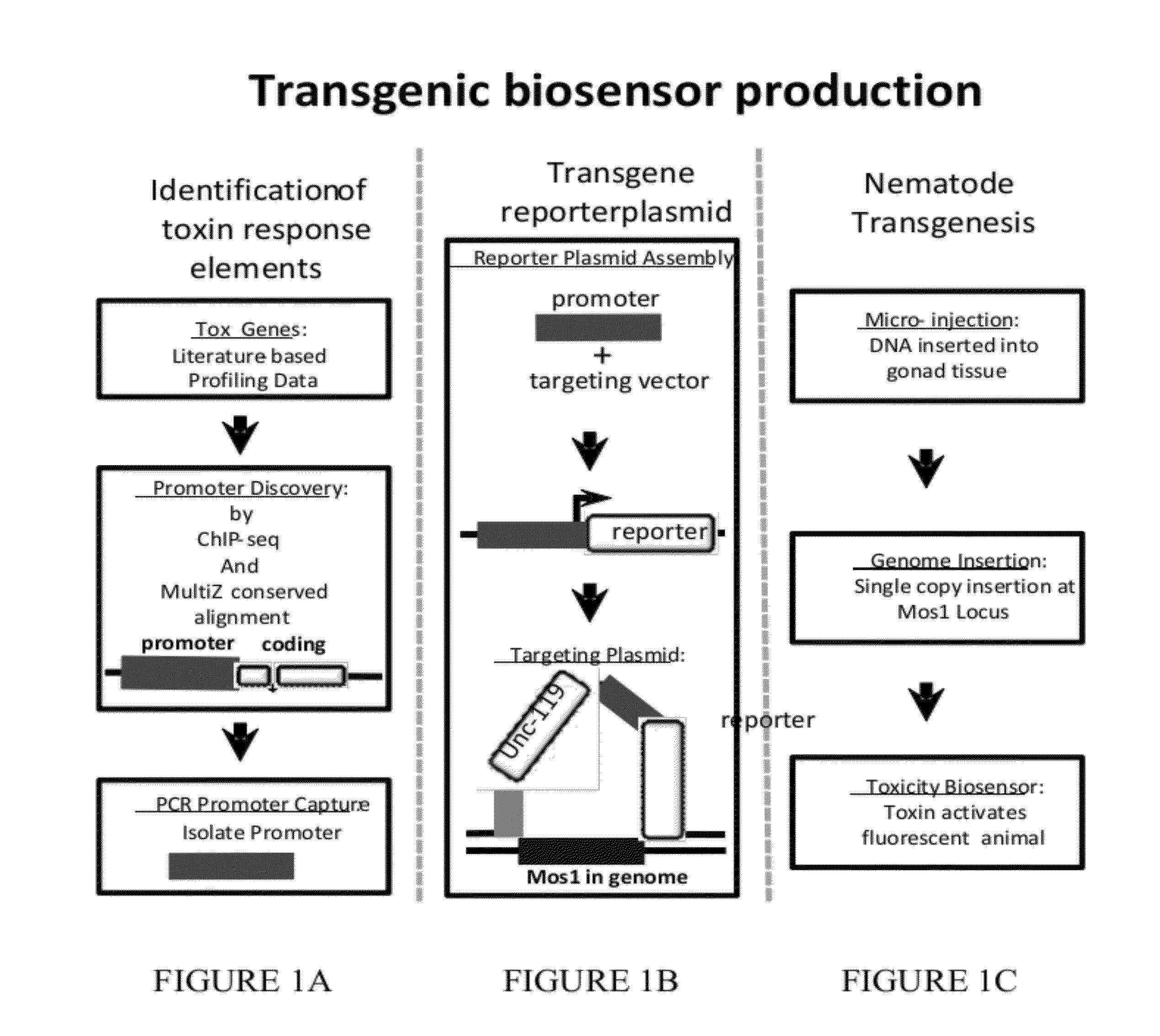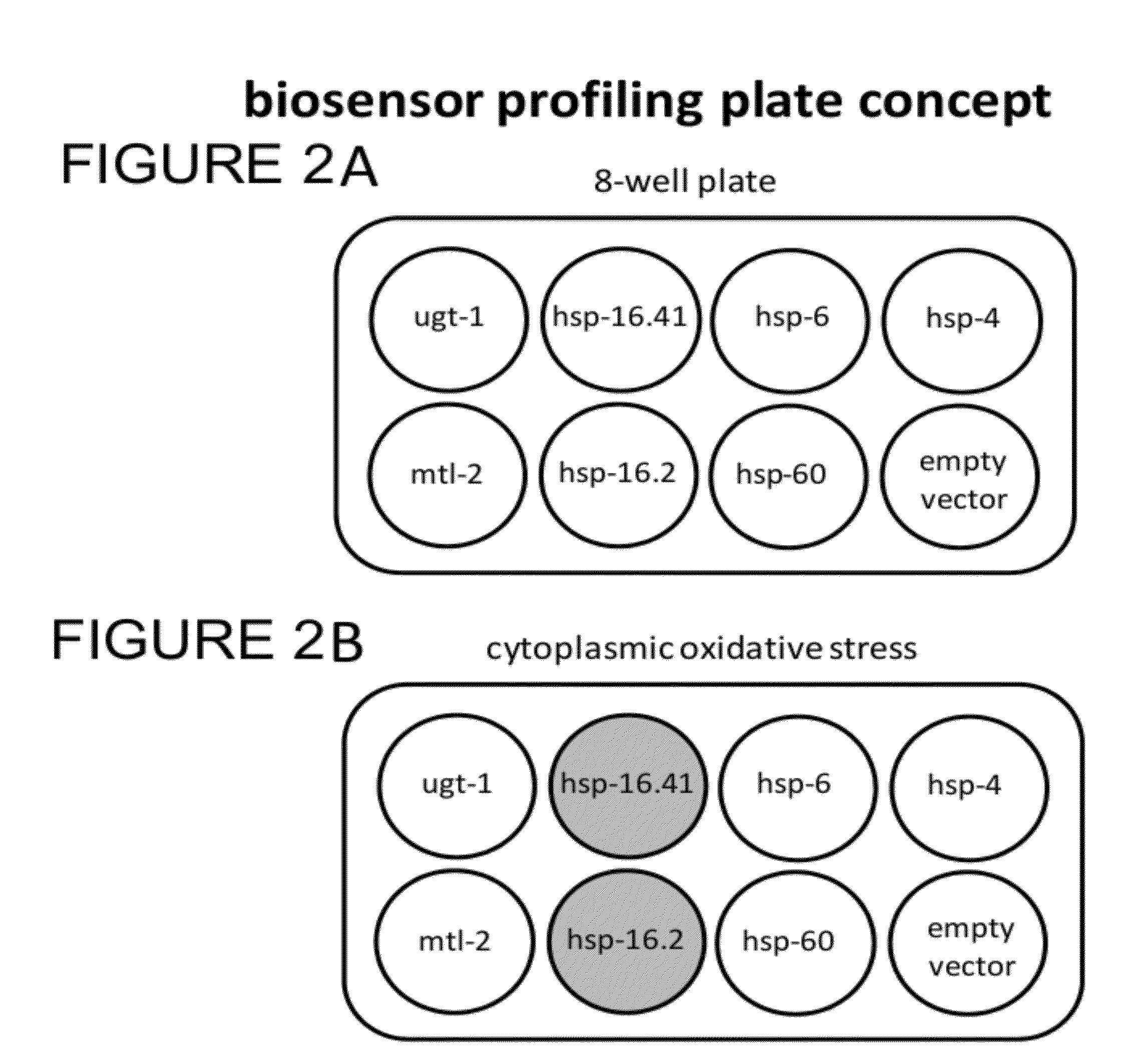Transgenic biosensors
a biosensor and transgenic technology, applied in the field of transgenic biosensors, can solve the problems of inability to extrapolate, high attrition rate of drug development, and enormous drain of resources
- Summary
- Abstract
- Description
- Claims
- Application Information
AI Technical Summary
Problems solved by technology
Method used
Image
Examples
example 1
Studies in C. elegans Having a hsp-16 Promoter-Red Fluorescent Protein Transgene
[0145]The results described herein demonstrate remarkable responses of the whole organism biosensor to toxic insults (such as: heat shock, cadmium, arsenic, etc). For instance, a protein homeostasis reporter was created by fusing heat shock protein to a nuclear localized red fluorescent protein (hsp-16.42::hRFP) (the materials and methods for the construction of the transgenic organism are described in more detail in the examples below). Exposure to heat toxicity generates induction of nuclear localization. This heat shock gene reporter was screened for gene induction capacity using a heat-shock protocol. The hsp-16::hRFP construct is exposed to a 1 hr incubation at 30 C. Gene induction was screened 4 to 24 hrs after heat shock. Significant red fluorescence is observed in the nuclei of heat-shocked worm relative to control (FIG. 5).
[0146]Toxin sensitivity of hsp-16 was confirmed with exposure to heavy me...
example 2
Control Reporter
[0147]Advantageously, the transgenic animals described in these examples can have a control reporter (e.g., constitutively expressed). Exposure to some selected agents or toxins can lead to shortened life-span, lower brood sizes or other effects that need to be controlled. The problem becomes most pronounced in chronic assays. For instance, exposure to cadmium for 72 hrs leads to significant population effects (FIGS. 4A, B, and C). Thus, it was determined a control for population mass differences between assay wells is desirable. Introduction of a second constitutively expressed reporter gene can be used to control for various population differences.
[0148]To create a population control in the fluorescence reader assays, the hsp-16::hRFP was crossed into a line containing a constitutively-expressed neuronal marker (unc-47::GFP). Expression of the control reporter remains constant, while the inducible reporter responds to heat shock (FIGS. 5A and B). The use of a const...
example 3
COPAS Cytometry
[0149]The fluorescent expression patterns of individual nematodes was rapidly quantifiable using flow cytometry. The hsp-16::hRFP construct in unc-47::GFP background was sent subjected to COPAS biosorting analysis. Induction of the red fluorescence was observed (FIG. 6A) and COPAS biosorting generated size-dependent profiles for red and green fluorescence expression (FIG. 6B). As expected, the levels of fluorescence increase proportionally with nematode age.
PUM
| Property | Measurement | Unit |
|---|---|---|
| fluorescent | aaaaa | aaaaa |
| luminescent | aaaaa | aaaaa |
| fluorescence | aaaaa | aaaaa |
Abstract
Description
Claims
Application Information
 Login to View More
Login to View More - R&D
- Intellectual Property
- Life Sciences
- Materials
- Tech Scout
- Unparalleled Data Quality
- Higher Quality Content
- 60% Fewer Hallucinations
Browse by: Latest US Patents, China's latest patents, Technical Efficacy Thesaurus, Application Domain, Technology Topic, Popular Technical Reports.
© 2025 PatSnap. All rights reserved.Legal|Privacy policy|Modern Slavery Act Transparency Statement|Sitemap|About US| Contact US: help@patsnap.com



